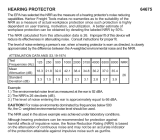Page is loading ...

REUSABLE CORDED EARPLUGS
The EPA has selected the NRR as the measure of a hearing protector’s noise reducing capabilities.
Harbor Freight Tools makes no warranties as to the suitability of the NRR as a measure of actual
workplace protection since such protection is highly dependent on user training, motivation, and
utilization. A better estimate of workplace protection can be obtained by derating the labeled NRR
by 50%.
The NRR calculated from this attenuation data is 25. Improper fit of this device will reduce its
effectiveness in attenuating noise. Consult instructions for proper fit.
The level of noise entering a person’s ear, when a hearing protector is worn as directed, is closely
approximated by the difference between the A-weighted environmental noise and the NRR.
4791-91.3SISNAATADNOITAUNETTA
tseT
)zH(seicneuqerF
521052005000100020513000400360008RRN
naeM
)Bd(noitaunettA
0.15.018.
222.929.634.538.632.431.63
52
dradnaS
)Bd(noitaiveD
46.264.127.136.190.218.116.240.142.1
Example:
1.) The environmental noise level as measured at the ear is 92 dBA.
2.) The NRR is 25 decibels (dB).
3.) The level of noise entering the ear is approximately equal to 67 dBA.
CAUTION: For noise environments dominated by frequencies below 500 Hz, the C- weighted
environmental noise level should be used.
The NRR used in the above example was achieved under laboratory conditions.
Although hearing protectors can be recommended for protection against harmful effects of
impulsive noise, the Noise Reduction Rating (NRR) is based on the attenuation of continuous
noise and may not be an accurate indicator of the protection attainable against impulsive
noise such as gunfire.
ITEM 94328

Wear Instructions
1. Place smaller flange in ear canal, push and twist towards the
center of the head until the earplug seals snugly.
2. After both earplugs are inserted, place cupped hands over
both ears and compare the sound level. With properly fitted
earplugs, you should detect little or no difference in sound level.
If the one or both plugs are not fitted properly, remove and
reinsert the plug(s).
3. Earplugs may work loose during talking or chewing. Re-seat
as necessary.
4. Periodically, after use, disinfect the ends of the plugs that go
inside the ear with rubbing alcohol. Allow to dry completely
before storing.
5. Typical usable life: 1 year. Inspect plugs periodically, and discard
if torn, cracked, deteriorated, or otherwise damaged.
/




